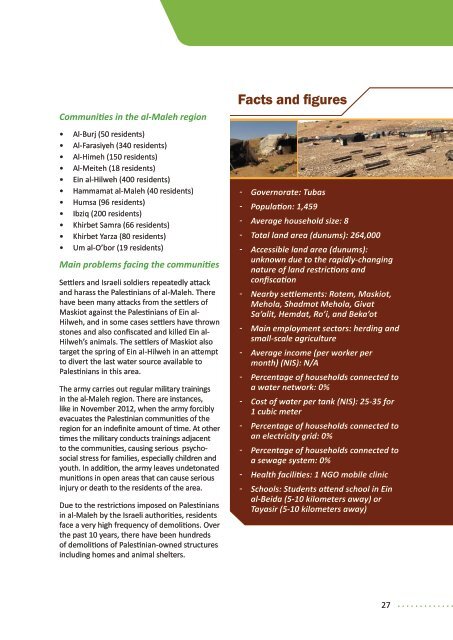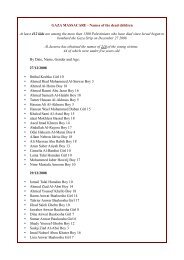Uprooted Livelihoods
Uprooted Livelihoods
Uprooted Livelihoods
Create successful ePaper yourself
Turn your PDF publications into a flip-book with our unique Google optimized e-Paper software.
Communities in the al-Maleh region<br />
•<br />
•<br />
•<br />
•<br />
•<br />
•<br />
•<br />
•<br />
•<br />
•<br />
•<br />
Al-Burj (50 residents)<br />
Al-Farasiyeh (340 residents)<br />
Al-Himeh (150 residents)<br />
Al-Meiteh (18 residents)<br />
Ein al-Hilweh (400 residents)<br />
Hammamat al-Maleh (40 residents)<br />
Humsa (96 residents)<br />
Ibziq (200 residents)<br />
Khirbet Samra (66 residents)<br />
Khirbet Yarza (80 residents)<br />
Um al-O’bor (19 residents)<br />
Main problems facing the communities<br />
Settlers and Israeli soldiers repeatedly attack<br />
and harass the Palestinians of al-Maleh. There<br />
have been many attacks from the settlers of<br />
Maskiot against the Palestinians of Ein al-<br />
Hilweh, and in some cases settlers have thrown<br />
stones and also confiscated and killed Ein al-<br />
Hilweh’s animals. The settlers of Maskiot also<br />
target the spring of Ein al-Hilweh in an attempt<br />
to divert the last water source available to<br />
Palestinians in this area.<br />
The army carries out regular military trainings<br />
in the al-Maleh region. There are instances,<br />
like in November 2012, when the army forcibly<br />
evacuates the Palestinian communities of the<br />
region for an indefinite amount of time. At other<br />
times the military conducts trainings adjacent<br />
to the communities, causing serious psychosocial<br />
stress for families, especially children and<br />
youth. In addition, the army leaves undetonated<br />
munitions in open areas that can cause serious<br />
injury or death to the residents of the area.<br />
Due to the restrictions imposed on Palestinians<br />
in al-Maleh by the Israeli authorities, residents<br />
face a very high frequency of demolitions. Over<br />
the past 10 years, there have been hundreds<br />
of demolitions of Palestinian-owned structures<br />
including homes and animal shelters.<br />
Facts and figures<br />
ͳ<br />
ͳ<br />
ͳ<br />
ͳ<br />
ͳ<br />
ͳ<br />
ͳ<br />
ͳ<br />
ͳ<br />
ͳ<br />
ͳ<br />
ͳ<br />
ͳ<br />
ͳ<br />
Governorate: Tubas<br />
Population: 1,459<br />
Average household size: 8<br />
Total land area (dunums): 264,000<br />
Accessible land area (dunums):<br />
unknown due to the rapidly-changing<br />
nature of land restrictions and<br />
confiscation<br />
Nearby settlements: Rotem, Maskiot,<br />
Mehola, Shadmot Mehola, Givat<br />
Sa’alit, Hemdat, Ro’i, and Beka’ot<br />
Main employment sectors: herding and<br />
small-scale agriculture<br />
Average income (per worker per<br />
month) (NIS): N/A<br />
Percentage of households connected to<br />
a water network: 0%<br />
Cost of water per tank (NIS): 25-35 for<br />
1 cubic meter<br />
Percentage of households connected to<br />
an electricity grid: 0%<br />
Percentage of households connected to<br />
a sewage system: 0%<br />
Health facilities: 1 NGO mobile clinic<br />
Schools: Students attend school in Ein<br />
al-Beida (5-10 kilometers away) or<br />
Tayasir (5-10 kilometers away)<br />
27



